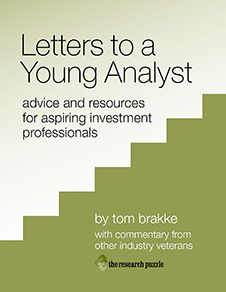
- Wednesday, April 8th, 2009
- time and motion
-
In the introduction to The Principles of Scientific Management, Frederick Winslow Taylor wrote that “the theory has been that if one could get the right man, the methods could be left safely to him.”ibiblio | The text in its entirety can be found on this collection of items in the public domain maintained by the University of North Carolina (whose mastery of another domain was exhibited Monday night). While Taylor’s work often concerned the study of industrial processes, he noted that the principles he espoused could be applied to all manner of organizational endeavor. Investment decision making springs to mind, but before we consider that, another dose of Taylor, whose list of reasons to produce his work began with this goal:
To point out, through a series of simple illustrations, the great loss which the whole country is suffering through inefficiency in almost all of our daily acts.
A century later, he would have a field day. Despite overwhelming evidence that multitasking inhibits performance, most of us are hooked on it. (I caught myself checking my email during the middle of writing that sentence.) Fresh back from a trip that included some car travel in an unfamiliar part of the country, it was clear that, no matter the region you are in, a very high percentage of drivers posing a threat on the road have cell phones pressed to their ears and no clue that they are out of sync with the world around them.
And chances are the fellow weaving down the airport corridor in front of you wasn’t getting lubed up in the bar before his flight; he’s just doing something (anything) on his BlackBerry or iPhone. Follow him to his seat on the plane, and you can see him fiddle with the gadget, put it down, glance again, cup it to avoid detection by the flight crew, play with it again, put it in the seat pocket, take it out, scroll for something new to do; and then repeat the routine over and over and over again.
We have convinced ourselves that this is productive work, that we are more efficient, but the inner Taylor knows better. While there are a few vocations where such hyperactivity and superficiality might work well, the clipped attention spans and lack of sustained effort we have built into our routines don’t add value. The question is what to do about it.
We don’t want to be micromanaged and, as in Taylor’s time, “the methods are left safely” to us, even though the tools at our disposal are different entirely. Even in an era of diminished expectations, investment decision makers get paid lots of money to do what they do, and it is assumed that they are experts at how to do it well. Sadly, all evidence suggests that as a group they (OK, we) fall into the same behavioral traps as everyone else.
Our shared proclivity for the use or misuse of handheld devices points to the belief that connectedness is a universal benefit regardless of the work being performed. One problem is that in the modern investment organization we have not divvied up chores in ways that match the tools to the tasks. A trader needs certain inputs and a disciplined approach to the information, and although more always seems better, there’s a point of diminishing returns. An analyst doing pure research should take a much different approach,the research puzzle | Above all else, give them some “green eyeshade time.” and a portfolio manager needs to be primarily about the business of crafting risk and return exposures. Yet, we give the people performing these distinctly different duties common implements and sources. It’s no surprise that they end up doing and redoing each others’ work, to no great effect.
Our informational tools have made the world seem smaller than it really is and, despite the proliferation of bloggers and twitterers (again, like me), the discourse seems to have gotten narrower rather than wider and, while deep in spots, much shallower overall. In upcoming postings, we will explore these dynamics further.
